New Customer?
Create your accountNo products
Prices are tax included
By buying this product you get 69 loyalty points
Viewed products
Dayton Audio OmniMic 40K Precision Measurement Microphone System
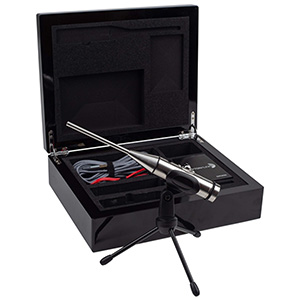
The Dayton Audio OmniMic 40K is a powerful and highly precise all-in-one acoustic measurement system, perfect for optimizing audio systems. Its omnidirectional USB microphone offers a calibrated measurement range from 5Hz to 40000Hz, and does so faithfully.
Furthermore, the Photolink module can calculate the acoustic offset (AOO) thanks to a precise time-of-flight. This feature is ideal for loudspeaker design or Hi-Fi system calibration.
Accompanied by intuitive software, this precision measurement microphone offers numerous possibilities for measuring frequency response, sound pressure and harmonic distortion - all the components you need to design or perfect your audio system, whether you're an amateur or a professional.
Find out more about the main benefits of the Dayton Audio OmniMic 40K :
- Accurate response from 5 to 40000Hz using the unique calibration files
- High dynamic range allows precise and distortion free measurements up to 145dB
- Instantly calculates acoustic time-of-flight providing actual delay and true phase response
- Built-in 2.83V indicator for standardized frequency measurements
- Custom 4mm capsule and small aperture enable omnidirectional performance up to 40kHz
- Quick and easy setup, even beginners will be making precision measurements in minutes
- Measures frequency response, true phase, distortion, SPL, loudspeaker compression, and much more
For measurements up to 40000Hz, your system will need to be equipped with a digital-to-analog converter (DAC) with a sampling frequency of 88.2kHz or more, and an amplifier capable of an almost flat response up to 40000Hz.

Dayton Audio OmniMic 40K: Designed for precise measurements
The Dayton Audio OmniMic 40K features an omnidirectional USB microphone for precision measurement, coupled with an analog-to-digital converter (ADC) for flawless results. The 4mm capsule allows calibrated measurements beyond the audible spectrum over a frequency response range from 5Hz to 40000Hz. Moreover, the compact aperture minimizes internal reflections and edge diffraction, ensuring a coherent response even when sound arrives significantly off-axis. This enables the microphone to maintain outstanding omnidirectional performance.
In addition, its internal high-voltage circuitry offers an extremely wide dynamic range for measurements up to 145dB without compression or distortion. In addition, an attenuation switch ensures that the outputs are perfectly aligned with the ADC to maximize detail and accuracy.
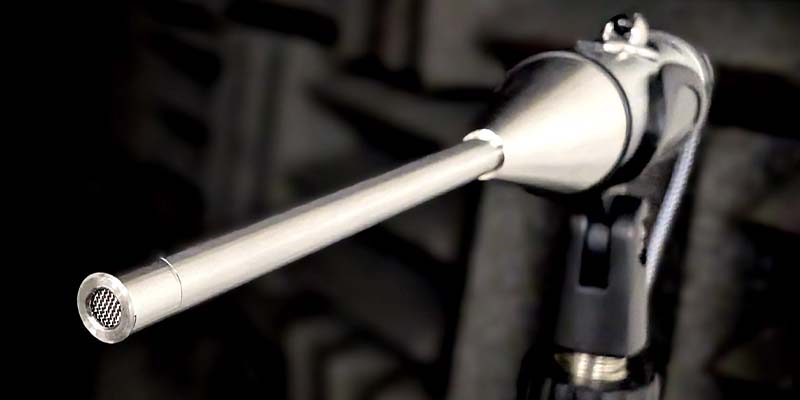
Dayton Audio OmniMic 40K: Photolink device for precise time-of-flight capture
An infrared device enables the Photolink device to accurately capture the time of flight and distance between the acoustic source and the microphone. It's this feature in particular that sets the Dayton Audio OmniMic 40K apart from the competition. Establishing an optical connection with the microphone enables precise calculation of the time of flight and distance between the acoustic source and the microphone capsule. This is crucial for accurate delay measurement and true phase capture, both of which are essential for determining acoustic origin offset and creating accurate on- and off-axis simulations when designing a multi-way loudspeaker system or loudspeaker array. The PhotoLink also features a visible 2.83 V indicator to facilitate consistent adjustment of signal level between measurements, which is essential for maintaining comparable sensitivity between different loudspeakers. To top it all off, the PhotoLink device operates passively, making installation and operation a breeze.
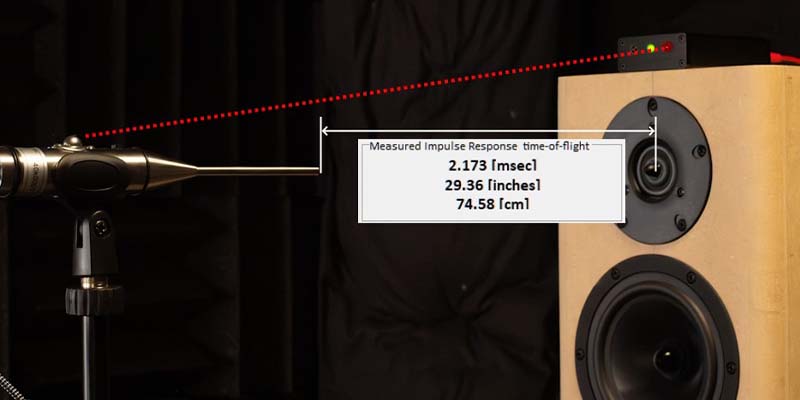
Dayton Audio OmniMic 40K: Easy-to-install software
Easy to use, the OmniMic 40K features intuitive software that lets you start testing within minutes of unpacking. Every aspect of the sound, from distortion up to 20,000 Hz to precise time-of-flight, is easily accessible. Beyond functionality, its compact, portable design and affordable price make it an unrivalled choice for acoustic measurement.
All the essentials are included: OmniMic 40K microphone, PhotoLink, test leads, 5m (16.4 ft) USB cable, compact microphone stand, microphone clip and protective wooden case, making it ready for immediate use in the field.
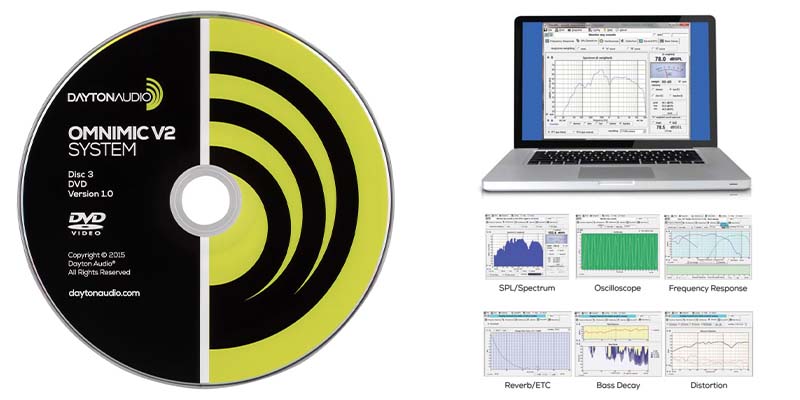

Frequency & Impulse Response
Frequency Response is a curve that shows how strongly an audio system reproduces different parts of the frequency range. A frequency response is related to its "impulse response" (the pressure signal that a speaker or sound system would make if it were fed by an extremely short pulse). Up to 40 saved Frequency Response curves (previously saved in "FRD" files) can be displayed on-screen simultaneously with the current measurement.

Polar Response
The purpose of a Polar Display is to reveal how the frequency response of a loudspeaker varies with horizontal or vertical angles from the baffle. Speaker designers generally design loudspeakers for a specified (usually, flat) frequency response at a position on-axis of a speaker and at some assumed distance from the baffle.

Harmonic Distortion
Harmonic distortion is the unwanted addition of new tones to the original audio signal. These distortion products occur at multiples of the original frequency and are centered on the harmonics of the original. For example, a 1kHz fundamental that has been subjected to harmonic distortion will produce energy at 2kHz (2nd harmonic), 3kHz (3rd harmonic), 4kHz (4th harmonic), and so on. OmniMic 40K will display 2nd thru 5th harmonics along with the total harmonic distortion.

Time of Flight and True Phase
When developing a speaker system, accurately identifying the acoustic center of each driver is critical to ensure that simulations align with real-world outcomes. The Photolink device establishes an optical link with the OmniMic 40K microphone, enabling precise measurements of both delay and distance between the acoustic source and the microphone. This integration streamlines the design and simulation process by eliminating any guesswork, or unnecessary steps.

Cumulative Spectral Decay
A waterfall (or CSD) illustrates, on a 3-D graph, how a speakers' energy decays or is radiated over a range of frequencies. Waterfall plots are used by driver and loudspeaker designers for driver selection, to identify resonances or reflections, and to view driver and waveguide behavior.

SPL Meter / Spectrum Analyzer
The SPL (Sound Pressure Level) meter is a tool designed to accurately quantify the loudness of a source. Additionally, the spectrum analyzer provides detailed insight, displaying the relative SPL across various frequency bands.

Energy Time Curve
The curve shown is the energy relative to the level of the energy in the first peak as an impulse comes from the speaker and reflects around the room. In other words, imagine the speaker sent out a sudden pulse rather than the sweep this test uses.

Oscilloscope
Leverage the Oscilloscope to effectively visualize sound waveforms encompassing musical tunes, vocalizations, or emissions from loudspeakers. This tool offers precise insights into the dynamics and details of audio signals.

Bass Decay
Utilize the Bass Decay Analyzer to accurately gauge the decay of bass notes within a given space. This measurement is essential for comprehensively understanding and compensating for the influence of the room's acoustics on the lower frequencies.
Download your customized calibration file for OmniMic 40K
A unique serialized calibration .txt file will be available for your OmniMic 40K . Once you receive your microphone, Visit the Dayton Audio calibration download tool where you will be prompted to enter the serial number found on the base of your calibrated OmniMic 40K. After entering the serial number, your unique calibration .txt file will be available for you to download.
Microsoft .net Framework 3.5 is required for Omnimic V2 to function correctly. It is not installed by default in Windows 10 or 11.
Technical characteristics
| Specifications | |
|---|---|
| Product type | Measurement microphone |
| Microphone type | Omnidirectional |
| Frequency response | 5Hz-40000Hz |
| SPL max. | 145dB with attenuation on (121dB with attenuation off) |
| Connector | USB-B |
| Dimensions | 25.5 x 219mm |
| Weight | 185g |
| Photolink | |
|---|---|
| Optical output | Infrared |
| Voltage indicator | Green = 2.83V (± 0.1V) Red = >2.83V |
| Power handling | 350W RMS |
| Dimensions | 25.5 x 63.5 x 96mm |
| Weight | 203g |
| General | |
|---|---|
| Gross weight | 2.3 kg |
| Package dimensions | 8.3 x 28 x 23cm |
| Package | 1x OmniMic 40K microphone 1x PhotoLink 1x Tripod 1x Microphone clip 1x USB-A to USB-B cable 1x Test cable (red/black, 1m) |
No reviews at this time.


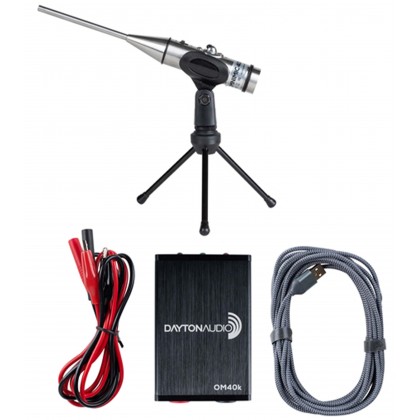








![[GRADE S] FIIO KA2 LIGHTNING Portable DAC Headphone Amplifier 2x CS43131 32bit 384kHz DSD256](https://www.audiophonics.fr/61299-thumb_default/fiio-ka2-lightning-portable-dac-headphone-amplifier-2x-cs43131-32bit-384khz-dsd256.jpg)
![[GRADE S] TOPPING DX7 PRO Balanced DAC Headphone Amplifier ES9038Pro Bluetooth 5.0 aptX HD LDAC 32bit 768kHz DSD1024 Black](https://www.audiophonics.fr/47119-thumb_default/-grade-s-topping-dx7-pro-balanced-dac-headphone-amplifier-es9038pro-bluetooth-50-aptx-hd-ldac-32bit-768khz-dsd1024-black.jpg)
![[GRADE S] GUSTARD C18 Master Clock OCXO 10MHz Silver](https://www.audiophonics.fr/67112-thumb_default/gustard-c18-master-clock-ocxo-10mhz-silver-stockb.jpg)
![[GRADE B] DAYTON AUDIO SD270A-88 Speaker Driver Subwoofer DVC 80W 4 Ohm 88dB 26Hz-2000Hz Ø25.4cm](https://www.audiophonics.fr/67029-thumb_default/dayton-audio-sd215a-88.jpg)



















